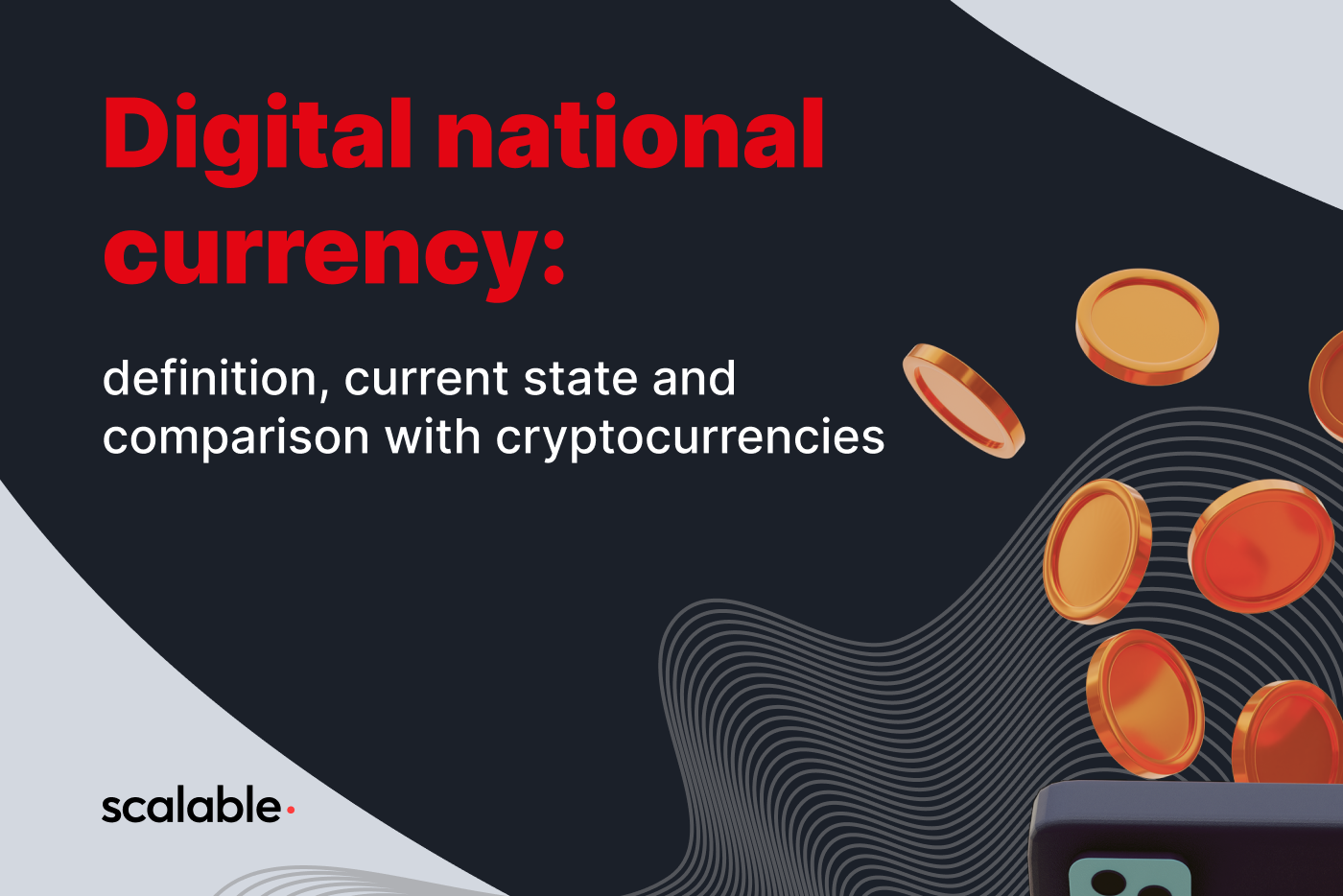
In recent years, central banks across the world revealed their intentions to establish local central bank digital currency (CBDC).
CBDC is a digital representation of digital money built on a blockchain or distributed ledger issued by central banks. Nowadays, over 80% of the world’s central banks are similarly engaged in pilots or other central banks digital currency (CBDC) activities.
![Graph 1: Central Bank Digital Currencies Status [4]](https://scalablesolutions.io/wp-content/uploads/2022/02/Graph-1-CBDC.png)
Graph 1: Central Bank Digital Currencies Status [4]
Number of central bank digital currencies by maturing stage:
Launched: (2)
Pilot: (18)
Proof of concept: (13)
Research: (58)
Cancelled: (5)
Countries leading the CBDC race
There are three jurisdictions that have already launched their CBDC projects by 2022, which are the Bahamas, Nigeria and Eastern Caribbean Currency Union.
The first national digital currency in the world was the Bahamian “Sand Dollar”. Starting from October 2020, country residents can open digital currency accounts, store it in an e-wallet approved by the central bank and use it for payments. According to the latest IMF FinTech report, in late 2021, the number of active Sand Dollar wallets was around 20,000 in a population of about 400,000.
Nigerian authorities launched their digital currency (eNaira) in October 2021. Regardless of citizenship, anyone can access digital naira by opening a virtual wallet on their smartphone, make payments through mobile platforms and make investments. The currency is not tied to a bank account, therefore it can be used by people who do not have access to the banking system. As NairaMetrics reported, eNaira records 694,000 downloads after 95 days of its launch.
Eastern Caribbean Central Bank became the first monetary authority, which back in March 2021 issued blockchain-based digital currency DCash. The ECCB suggests that the digital currency will help to increase financial inclusion, competitiveness and resilience across the islands’ economies, as well as to cut the use of traditional notes and coins by 50% by 2025. The seven countries involved are Antigua and Barbuda, Dominica, Grenada, Montserrat, St. Kitts and Nevis, Saint Lucia, and St. Vincent and the Grenadines.
China began the development of a retail CBDC in 2014. In April 2020, the Chinese central bank (PBOC) first began rolling out the e-CNY (Chinese CBDC) in pilot zones. This pilot program has been expanded through invites and cash incentives and, according Reuters citing PBOC, over 140 million users have registered for e-CNY accounts by October 2021, which they can access through a smartphone app. Reuters reported that e-CNY payments exceeded 2 million yuan ($315,761) per day in its latest pilot at the Beijing Winter Olympics 2022.
France has a strong position in the global CBDC race. The Central Bank of France is piloting the use of the digital euro for interbank settlements. In May 2020, the regulator together with Societe Generale tested the CBDC by issuing and instantly redeeming €40 million worth bonds through the digital euro. The Bank of France is also currently piloting with the Monetary Authority of Singapore, simulating cross-border and cross-currency transactions using the digital euro and the digital Singapore dollar. In November 2021, the results of piloting wholesale CBDC projects were recognized as successful.
Sweden has been testing the E-crown since 2020 and plans to complete the review of the project by November 2022.
Developing countries such as Thailand, Bhutan, South Korea, Singapore and Brazil announced to launch CBDC pilots in 2022. Jamaica has completed a CBDC pilot at the end of 2021 and expects to roll out the CBDC in the first quarter of 2022.
It’s worth mentioning that some countries have been developing more than one digital currency, and several currency projects are prepared intercountry. For example, Switzerland has started both e-franc (for consumer’s operations or retail) and project Halvetia (payments between financial market participants or wholesale), while France, as mentioned above, has partnered with Singapore, Switzerland, Tunisia and other associations as an experiment to simulate cross-border and cross-currency transactions.
Can CBDC and cryptocurrency coexist with each other?
CBDCs are not a part of the crypto ecosystem. The main differences between crypto and central bank digital currencies are:
- Cryptocurrencies are decentralised, while CBDCs are centralised;
- Cryptocurrencies keep anonymity, CBDCs would allow central banks to know the funds’ holders;
- Cryptocurrencies are created by a distributed network or blockchain, CBDCs would likely run on different technological platforms (the use of blockchain is possible).
Many information sources have agreed that CBDCs will not replace bitcoin or cryptocurrencies and they can coexist with each other. The analysts are sure that CBDCs will speed up the transaction and regular payments, while cryptocurrencies will continue to function, thrive as part of the crypto asset class and offer crypto players advantages related to crypto operations.
However, some countries intend to develop CBDCs in an attempt to reduce the threat from independent digital currencies, which from the country’s point of view, could potentially threaten its ability to manage their economies.
Conclusion
A large number of countries are currently involved in CBDC researching, testing and/or launching their own CBDC framework. The development and speed of implementation of central bank digital currency depends on the peculiarities of the national payment system. In this connection, countries with a weak banking sector use digital currency as the basis for their payment infrastructure. States with a strong banking sector carry out a thorough analysis before making decisions in favour of CBDC to prevent risks related to financial stability. It’s reasonable to suggest that after a strong 2021, the CBDC market will continue its evolution in 2022.
***
Read also
Crypto Industry Regulatory Risks. 2022 Rating by Country
2021 Market Overview: Crypto Exchanges Market Activity, Venture Financing, Crypto Unicorns, M&A
References:
- “Can cryptocurrencies and CBDCs coexist in this era-defining economic landscape?”. Economictimes, December 08, 2021.
- “Could 2022 be the year of the CBDC?”. FinTech Global, January 6, 2022
- “Emergency Decree on Digital Asset Business B.E. 2561”. 2018
- Jonas, G, et al. “Central Bank Digital Currency (CBDC) Tracker.” CBDC Tracker, BCG, Digital Euro Association, R3, Firmshift, 22 Jan. 2021, cbdctracker.org/.
- Mark, J. “Over $315,000 in digital yuan used every day at Olympics, PBOC official says”. Thomson Reuters, February 16, 2022
- Mookerjee, A. “What If Central Banks Issued Digital Currency?”. Harward Business Review, October 15, 2021
- Mossavar-Rahmani, S, et al. “Digital Assets: The Beauty Is Not in the Eye of the Beholder”. Goldman Sachs, June 1, 2021
- Olisah, C. “Emefiele says eNaira has recorded about 600,000 downloads, digital transactions have risen by over 153%”. Naira Metrics, November 27, 2021
- Soderberg, G, et al. “Behind the Scenes of Central Bank Digital Currency”. IMF, February 9. 2021

